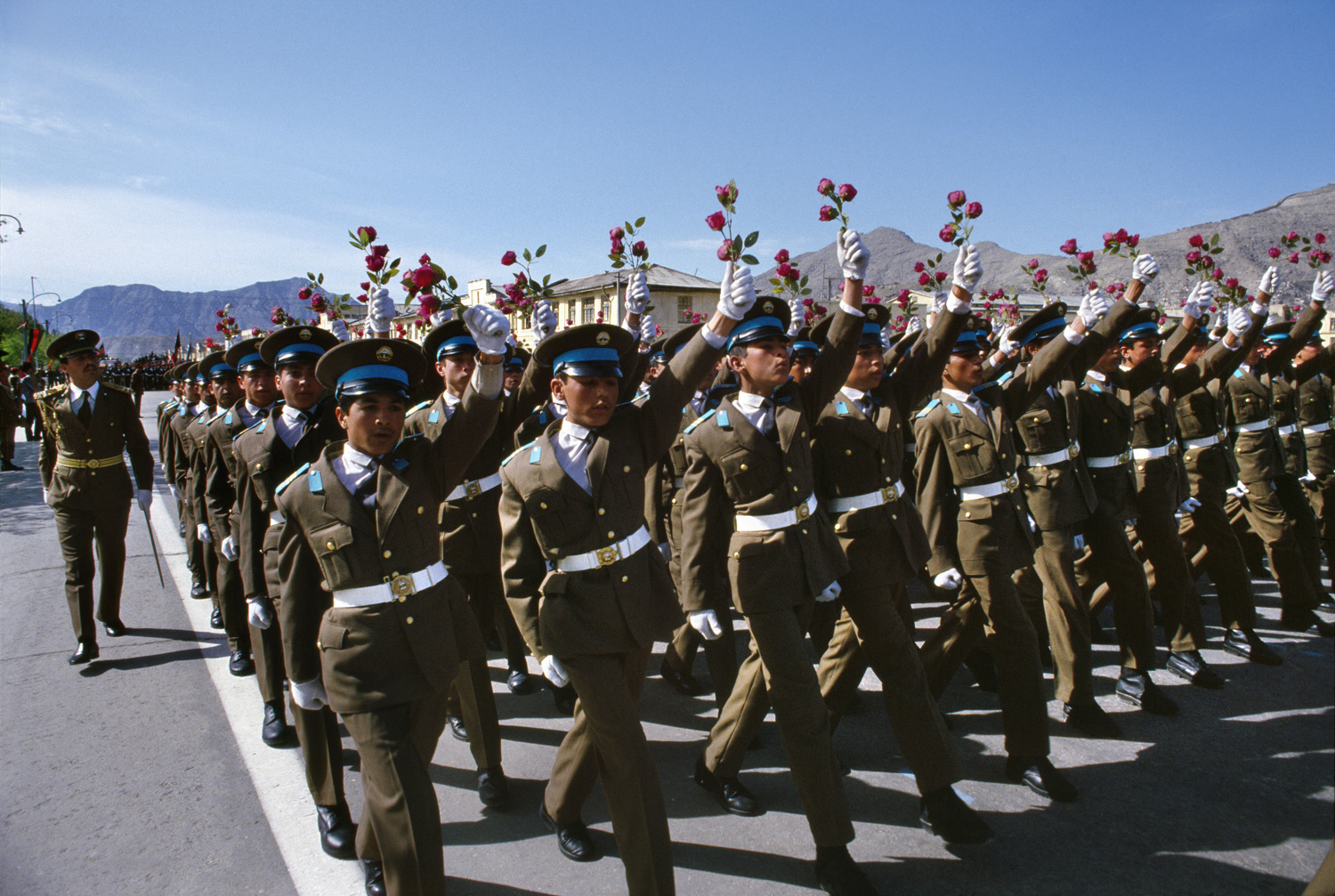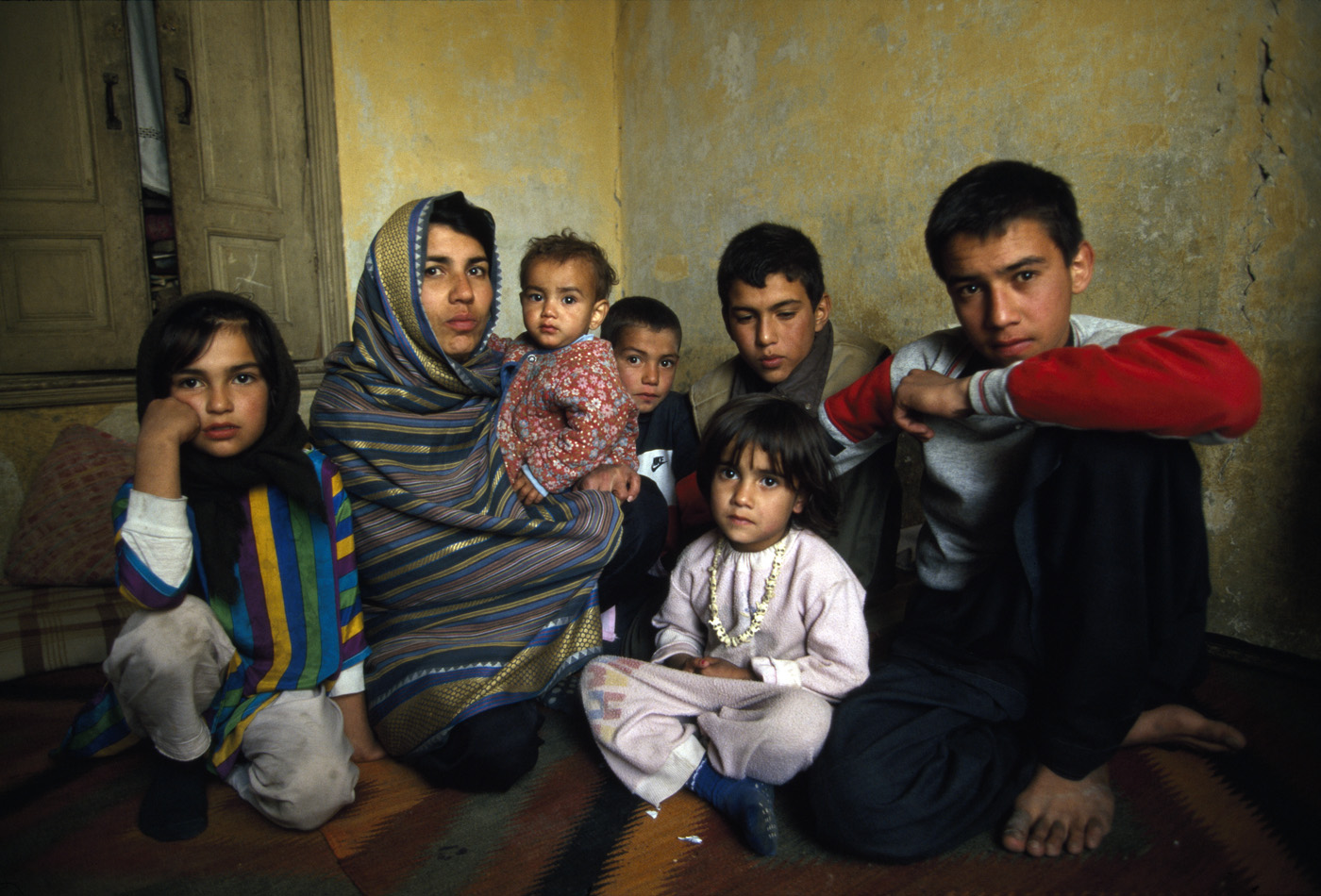Afghanistan: A Distant War
Images of historical and political events covering 25 years from 1988 to 2013.

May 1988: An Afghan soldier hands a flag in solidarity to a departing Soviet soldier in Kabul on the first day of the army’s withdrawal from Afghanistan.

March 1989: Afghan mujahideen move toward the front line during the battle for Jalalabad, in eastern Afghanistan.

March 1989: Afghan refugees take cover from a bombing attack by the Afghan Air Force during the battle for Jalalabad.

April 1989: Military academy cadets march in Kabul to celebrate the Saur Revolution, the Afghan Communist Party’s seizure of power 11 years earlier.

May 1990: Afghan mujahideen move about the Zhawar training complex controlled by Jalaluddin Haqqani in Khost, Afghanistan. The Zhawar camps along the Afghan-Pakistan border became the main base for Osama bin Laden and his Arab followers.

May 1990: Arab Al Qaeda members and Afghan mujahideen jog at a Zhawar training camp outside of Khost, Afghanistan.

May 1990: Mujahideen commander Jalaluddin Haqqani at a base camp in Khost, Afghanistan. An ethnic Pashtun, Haqqani was an early convert to global jihad. Haqqani befriended Osama bin Laden in the late 1980’s and attracted Arab fighters to his training camps along the Afghan-Pakistan border.

April 1991: Afghan mujahideen inspect a Kabul government plane after they seized the Khost garrison. Provincial control gave Afghan mujahideen, Arabs enlisted by Al Qaeda, and Pakistani advisors valuable territory to establish base camps for training and resupply in Afghanistan.

September 1991: Afghans in the Bagh-e Babur, or Babur’s Garden, perform the attan, a traditional Afghan folk dance.

March 1992: A young boy sells government-owned newspapers on a Kabul street.

April 1992: Afghan Uzbek fighters under the control of Abdul Rashid Dostum fire on Hizb-i-Islami forces of Gulbuddin Hekmatyar in the southwest part of Kabul, during the mujahideen seizure of the city. The takeover of Kabul became a battle between mujahideen groups, divided along ethnic and geographic regions, attempting to seize control of government ministries.

March 1993: A Kabul family flees its home during factional fighting between President Rabbani’s government forces and opposition Hizb-i-Islami and Hezb-I-Wahdat fighters in western Kabul. The fighting marked a continuation of an operation in which hundreds of unarmed Hazaras were killed. The dispute for control of western Kabul involved Sunni militias against the Shia Hezb-I-Wahdat.

March 1994: Boys working with government militiamen fill water buckets from a hand pump on Jade Maiwand, Kabul’s former business district and a front line between factional groups. Food, water and fuel were retrieved during short-lived periods of peace.

October 1996: A Taliban mullah speaks to a crowd gathered in central Kabul after Taliban forces took control from the Rabbani government.

September 1996: Taliban soldiers fire a rocket at retreating forces of the Northern Alliance army north of Kabul. The capital fell to the Taliban on September 27, 1996. The Kabul government’s defenses collapsed with little resistance to the Taliban advance.

October 1996: A widow of an Afghan mujahideen fighter seeks refuge with her children in an unheated apartment in Kabul. The women’s husband was killed while fighting the Taliban. Kabul has between 30,000 and 50,000 war widows with little means of support and their situation became more precarious once the Taliban took over in September 1996.

May 1997: A Taliban soldier walks away from where his comrade was shot down in Mazar-I-Sharif. A recent power sharing agreement with Uzbek and Hazara militias and the Taliban broke down after 36-hours. The Taliban were unaware that the Uzbeks and Hazaras had drawn them into a trap.

May 1997: A Taliban soldier fires a rocket-propelled grenade into a doorway where a local Uzbek militiaman had opened fire on a column of Taliban fighters. After two days of fighting, local militiamen had killed over 800 Taliban. Revenge from the Taliban came within a year.

November 2001: An Afghan shepherd in Chowkar Karez, Kandahar province, shouts to his children to lead their flock of goats over to him. He stands by a wall bombed by U.S. and French aircraft. The death toll was nearly 25 civilians, although local residents claim Al Qaeda or Taliban were not present during the attacks. The U.S. Army called the town a military target occupied by one of the groups.

December 2001: Pakistani Taliban captured outside of Kabul while fighting Northern Alliance troops. All four were from Pakistan’s Punjab province, trained at a local religious center, and recruited by Jaish-i-Mohammed, a militant Islamic group associated with Osama bin Laden.

March 2009: Afghan National Police stand at a guard post in Qarabagh, Ghazni province. The Taliban controlled more than 40 of the 464 villages in Qarabagh district.

August 2006: Three wounded U.S. Army soldiers from the 10th Mountain Division await evacuation by helicopter from Kamdesh, Nuristan province. They were ambushed and suffered wounds to their eyes and foreheads.

A U.S. soldier shakes the hand of an Afghan youth outside the town of Jalrez in Wardak province. The hilltop overlooking apple and almond orchards had fighting trenches, left of the soldier, built by Afghan mujahideen 25 years ago in their fight against Soviet forces.

August 2009: U.S. Marines investigate possible bomb making ingredients at a farmer’s home in Khan Neshin, Helmand province. The team concluded the fertilizer was for agricultural use.

August 2009: U.S. Marines from the 2nd Light Armored Reconnaissance Battalion hold a briefing after a patrol in Khan Neshin, Helmand province. Taliban fighters, forced to flee by the influx of 4,000 Marines into the province, had controlled southern Helmand for nearly four years.

August 2009: An Afghan farmer stands outside his home as a U.S. Marine patrol walk past in Khan Neshin, Helmand province.

September 2009: A valley in the Hindu Kush mountains in Kunar province, viewed from a U.S. Army helicopter.

May 2013: A policeman stops traffic as schoolgirls cross a main roadway in western Kabul. Female literacy rate in Kabul is 37%, the highest in the country.

May 2013: A U.S. Army soldier at Bagram Air Base sits on top of a Mine-Resistant All-Terrain Vehicle, MRAP, looking for any loose ammunition before the vehicle is shipped back to the United States as part of the withdrawal of U.S. forces from Afghanistan.

May 2013: A contingent of American troops concludes their tour in Afghanistan and prepare to fly home from Bagram Air Base. Others arrive, wearing their helmets. With the Western military presence winding down in the months before the December 2014 withdrawal deadline, the United States continues to provide the largest contributions of men, women, and assistance.

May 2013: Car and truck traffic back up near the Pul-e-Sokhta bridge in western Kabul.






























